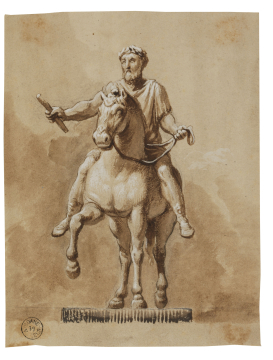
Browse
Reference number
Purpose
Aspect
Signed and dated
- Undated, probably 1762-63
Medium and dimensions
205 x 158
Hand
Notes
The set of pen and wash drawings with heightening, Adam vol.7/21-44, are all designs for the relief decoration of James Adam's Parliament House scheme of 1762/63. The predominant theme is British history and the figures are dressed in either early seventeenth-century or classical costume. The principal draughtsman was Antonio Zucchi (1726-95), although some of the figure compositions are probably the work of Agostino Scara, of whom James Adam wrote that he '... draws figures full as well as Brunias...' (Fleming, op.cit., p.279). Adam gave great emphasis in his Parliament scheme to the role of decorative sculpture and this probably explains the survival of so much material of this sort. In his unfinished essay of 1762, Adam explained: 'What is meant by outside decoration is sculpture, statues and bas-reliefs, together with foliage, trophies, frets, interlacings and a thousand such ornaments which, if properly applied, give such amazing magnificence and render an ediface so wonderfully interesting...' (Fleming, op.cit., p.317).
Level
Sir John Soane's collection includes some 30,000 architectural, design and topographical drawings which is a very important resource for scholars worldwide. His was the first architect’s collection to attempt to preserve the best in design for the architectural profession in the future, and it did so by assembling as exemplars surviving drawings by great Renaissance masters and by the leading architects in Britain in the 17th and 18th centuries and his near contemporaries such as Sir William Chambers, Robert Adam and George Dance the Younger. These drawings sit side by side with 9,000 drawings in Soane’s own hand or those of the pupils in his office, covering his early work as a student, his time in Italy and the drawings produced in the course of his architectural practice from 1780 until the 1830s.
Browse (via the vertical menu to the left) and search results for Drawings include a mixture of Concise catalogue records – drawn from an outline list of the collection – and fuller records where drawings have been catalogued in more detail (an ongoing process).

